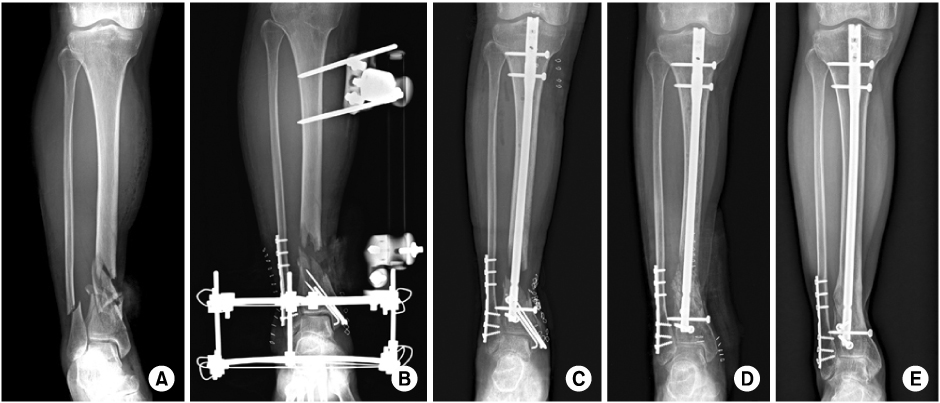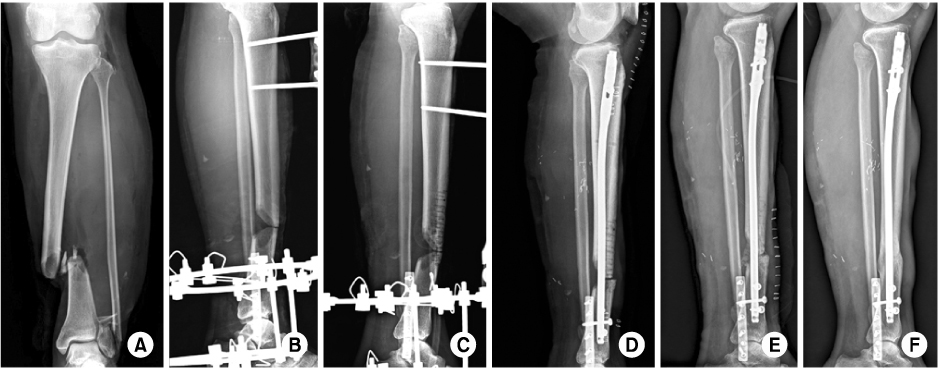J Korean Fract Soc.
2012 Oct;25(4):288-294. 10.12671/jkfs.2012.25.4.288.
Treatment for Bone Defect of Open Tibial Fractures by Using Intramedullary Nail Fixation with Autogenous Iliac Bone Graft
- Affiliations
-
- 1Department of Orthopedic Surgery, Keimyung University School of Medicine, Daegu, Korea. bkc@dsmc.or.kr
- KMID: 1434068
- DOI: http://doi.org/10.12671/jkfs.2012.25.4.288
Abstract
- PURPOSE
This study was conducted to evaluate the results of intramedullary nail fixation with autogenous iliac bone graft for defects of bone after tibial fractures.
MATERIALS AND METHODS
Ten patients with bone defects in tibial fractures who had been treated with intramedullary nail fixation with autogenous iliac bone graft between May 2005 and September 2008 with more than 12 month follow-up were subject to study. Of the 10 patients, 8 were male and 2 were female, and the mean age was 50.2 years (29~76 years). By cause of accident, motor vehicle accidents caused 9 cases, a crush caused 1 case, and the average follow-up period was 21.9 months (12~42 months). Radiologically, we analyzed the union of the bone defect on simple x-ray and clinical evaluation was performed using the estimate method of Mekhali.
RESULTS
This study reveals that there was radiological union in all 10 cases and the mean time to union was 8.4 months (5~18 months). By clinical evaluation according to Mekhali's estimate method, 9 patients had excellent outcomes and 1 patient had limitation of motion in the ankle joint rated as a fair clinical result. None of patients developed complications post-operatively.
CONCLUSION
Our study demonstrated that the intramedullary nail fixation with autogenous iliac bone graft can be a useful operative method because it can remove external fixators early and reduce complications, and autogenous bones have exceptional osteoconduction, osteoinduction, and bone-forming ability resulting in excellent union of bones.
MeSH Terms
Figure
Reference
-
1. Aaron AD, Wiedel JD. Allograft use in orthopedic surgery. Orthopedics. 1994. 17:41–48.
Article2. Aronson J, Johnson E, Harp JH. Local bone transportation for treatment of intercalary defects by the Ilizarov technique. Biomechanical and clinical considerations. Clin Orthop Relat Res. 1989. (243):71–79.
Article3. Awe SI, Rhyu KH, Lee TH. Short term result of bone marrow and morselized allograft without autogenous bone graft in bone defect. J Korean Musculoskelet Transplant Soc. 2004. 4:1–8.
Article4. Blokhuis TJ, Termaat MF, den Boer FC, Patka P, Bakker FC, Haarman HJ. Properties of calcium phosphate ceramics in relation to their in vivo behavior. J Trauma. 2000. 48:179–186.
Article5. Cattaneo R, Catagni M, Johnson EE. The treatment of infected nonunions and segmental defects of the tibia by the methods of Ilizarov. Clin Orthop Relat Res. 1992. (280):143–152.6. Cierny G 3rd, Zorn KE. Segmental tibial defects. Comparing conventional and Ilizarov methodologies. Clin Orthop Relat Res. 1994. (301):118–123.7. Dagher F, Roukoz S. Compound tibial fractures with bone loss treated by the Ilizarov technique. J Bone Joint Surg Br. 1991. 73:316–321.
Article8. Greenwald AS, Boden SD, Goldberg VM, Khan Y, Laurencin CT, Rosier RN. American Academy of Orthopaedic Surgeons. The Committee on Biological Implants. Bone-graft substitutes: facts, fictions, and applications. J Bone Joint Surg Am. 2001. 83-A:Suppl 2 Pt 2. 98–103.
Article9. Hwang C, Bae JY, Koo KH, et al. A comparative experimental study of allograft and porous hydroxyapatite as bone substitutes. J Korean Orthop Assoc. 2007. 42:545–552.10. Ilizarov GA. Clinical application of the tension-stress effect for limb lengthening. Clin Orthop Relat Res. 1990. (250):8–26.11. Jung GH, Jung SH, Kim JD, Cho Y. Allograft transplantation in the treatment of bone defect after bone tumor surgery. J Korean Musculoskelet Transplant Soc. 2006. 6:79–87.
Article12. Kang HJ, Kim TK, Kweon SH, Shim DM, Lee SI. The usefulness of hydroxyapatite bone transplantation in treatment of metaphyseal fracture with bone defect. J Korean Musculoskelet Transplant Soc. 2011. 11:36–41.
Article13. Karlström G, Olerud S. Percutaneous pin fixation of open tibial fractures. Double-frame anchorage using the Vidal-Adrey method. J Bone Joint Surg Am. 1975. 57:915–924.
Article14. Keating JF, Simpson AH, Robinson CM. The management of fractures with bone loss. J Bone Joint Surg Br. 2005. 87:142–150.
Article15. Kim HT, Yun PJ, Kim IB, Lee DH, Ahn MY, Chang HK. Osteogenic induction of periosteum-derived stem cells transplanted into rabbit long-bone defects. J Korean Orthop Assoc. 2006. 41:353–360.
Article16. Lee SK, Kim SJ, Chang CH, Jang JD, Park HS, Park JS. Treatment of long tubular bone defect of rabbit using autologous cultured osteoblasts mixed with fibrin. J Korean Orthop Res Soc. 2006. 9:29–39.
Article17. Lord CF, Gebhardt MC, Tomford WW, Mankin HJ. Infection in bone allografts. Incidence, nature, and treatment. J Bone Joint Surg Am. 1988. 70:369–376.
Article18. Marsh JL, Prokuski L, Biermann JS. Chronic infected tibial nonunions with bone loss. Conventional techniques versus bone transport. Clin Orthop Relat Res. 1994. (301):139–146.
Article19. Mekhail AO, Abraham E, Gruber B, Gonzalez M. Bone transport in the management of posttraumatic bone defects in the lower extremity. J Trauma. 2004. 56:368–378.
Article20. Paley D, Herzenberg JE, Paremain G, Bhave A. Femoral lengthening over an intramedullary nail. A matched-case comparison with Ilizarov femoral lengthening. J Bone Joint Surg Am. 1997. 79:1464–1480.
Article21. Paley D, Maar DC. Ilizarov bone transport treatment for tibial defects. J Orthop Trauma. 2000. 14:76–85.
Article22. Ring D, Jupiter JB, Gan BS, Israeli R, Yaremchuk MJ. Infected nonunion of the tibia. Clin Orthop Relat Res. 1999. (369):302–311.
Article23. Roh JY, Oh CW, Oh JK, et al. Bone transport over the intramedullary nail for defects of long bone. J Korean Fract Soc. 2008. 21:37–44.
Article24. Song HR, Kale A, Park HB, et al. Comparison of internal bone transport and vascularized fibular grafting for femoral bone defects. J Orthop Trauma. 2003. 17:203–211.
Article25. Webb LX. New techniques in wound management: vacuum-assisted wound closure. J Am Acad Orthop Surg. 2002. 10:303–311.
Article26. Younger EM, Chapman MW. Morbidity at bone graft donor sites. J Orthop Trauma. 1989. 3:192–195.
Article
- Full Text Links
- Actions
-
Cited
- CITED
-
- Close
- Share
- Similar articles
-
- Comparison of Intramedullary Nailing and Plate Fixation for the Treatment of Nonunion of the Long Bone Fracture on Lower Extermities
- Treatment of Tibial Fractures by Interlocking Intramedullary Nailling
- The reconstruction of posttraumatic craniofacial deformity using modified lefort II and III osteotomy and autogenous iliac bone graft
- Treatment with Unlearned Locked Intramedullary Nail for Open Tibial Fractures
- Comparison of External Fixation and Interlocking IM Nail in Open Tibial Fractures



